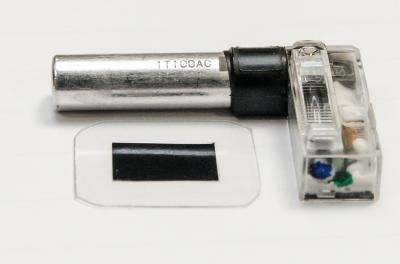Small but mighty Xenon flash for mobile phones: Great shots in the dark soon to be a reality

A Singapore invention looks set to equip mobile phones with a built-in, small yet powerful Xenon flash, allowing consumers to take great photos even in low-light conditions.
Scientists from Nanyang Technological University (NTU) have made a revolutionary capacitor that overcomes the limitations of current capacitors, which are needed to store enough energy to fire a powerful flash like those found on digital cameras but are too big to fit in slim mobile devices.
This invention by Associate Professor Lee Pooi See from NTU's School of Materials Science and Engineering, will be made a consumer reality in partnership with Xenon Technologies (XT), the world's largest Xenon flash manufacturer.
Made from polymers layered together, the new capacitor is at least four times smaller than current electrolytic capacitors and is several times faster than current ceramic-based capacitors. The multi-layered polymer capacitor is also able to deliver the same electricity charge needed to power high-intensity xenon flash light matching those found in digital cameras.

Through the university's Nanyang Innovation and Enterprise Office, NTU and XT entered into a Collaboration Agreement to research and develop a Multilayer Polymer Capacitor for xenon flash imaging applications.
Mr Jack Tuen, CEO of Xenon Technologies said: "This project will yield a breakthrough solution for the digital imaging industry, which will be the world's smallest Xenon flash. Our customers and consumers at large constantly demand for a proper xenon flash which can fit into increasingly smaller and beautiful form factor mobile devices. This is the answer which fulfils that need."
Prof Lee, whose researchers had worked on the invention for the past two and a half years, hopes that this collaboration with XT will accelerate the transfer of her innovation from research lab to industry.
"With XT's expertise in developing successful commercial products, we are confident that this collaboration will result in a disruptive innovation, not just in the area of flash technology, but also in the world of consumer electronics, as all computers and devices requires the use of capacitors in one way or another," she said.
The new breed of capacitors
Polymer capacitors such as the one developed by Prof Lee, generally possess a higher energy density than ceramic-based multilayer capacitors.
NTU's new material, a grafted co-polymer that stores charges similar to a multilayer ceramic capacitor, can be operated at high voltages. Capacitors made using this grafted co-polymer are flexible and much smaller than the conventional capacitors. In addition, the charge and discharge times of the capacitor are faster than other types of energy storage devices making it suitable for flash applications.
Currently, the polymer capacitor project is funded by Singapore's National Research Foundation (NRF) Proof-of-Concept grant. The NTU-Xenon team is expected to develop a working commercial prototype by September 2013.
Provided by Nanyang Technological University


















